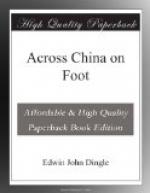Paddy Mblei Nglee.
Cooked Rice Mao Va.
Tree Ndong Ntao.
Fire To Teh.
Wind Chwa, Chiang Chta.
Earth Ta Ti.
Sun Hno, Nai Hnu.
Moon Hla Hlee.
Big Hlo Hlo.
Come Ta Ta.
Go Mong Mao.
Drink Ho Hao.
One A, Yi Ih.
Two Ao Ah.
Three Pie, Po Tsz.
Four Pei, Plou Glao.
Five Pa Peh.
Six Chou Glao.
Seven Shiang, I Shiang.
Eight Yi, Yik Yih.
Nine Chio Chia.
Ten Ch’it Kao.
The Miao language was until a year or two ago only spoken; it was never written, and no one ever dreamed that it could be written. At the time of the great Miao revival, when thousands of Miao made a raid on the mission premises at Chao-t’ong, and implored the missionaries to come and teach them, it was found absolutely necessary that the language should be reduced to writing, and the whole of this extremely creditable work fell to the Rev. Samuel Pollard, who may be characterized as the pioneer of this Christianizing movement in North-East Yuen-nan.
In reducing the language to writing, however, considerable difficulty was complicated by the presence of “tones,” so well known to all students of Chinese, itself said to be an invention of the Devil. Tones introduce another element or dimension into speech. The number of sounds, not being sufficient for the reproduction of all the spoken ideas, has been multiplied by giving these various sounds in different tones. It is as if the element of music were introduced according to rule into speech, and as if one had not only to remember the words in everything he wished to say, but the tune also.
The Miao people being so low down in the intellectual scale, and having never been accustomed to study, it was felt by the promoters of the written language that they should be as simple as possible, and hence they looked about for some system which could be readily grasped by these ignorant people. It was necessary that the system be absolutely phonetic and understood easily. By adapting the system used in shorthand, of putting the vowel marks in different positions by the side of the consonant signs, Mr. Pollard and his assistant found that they could solve their problem. The signs for the consonants are larger than the vowel signs, and the position of the latter by the side of the former gives the tone or musical note required.




